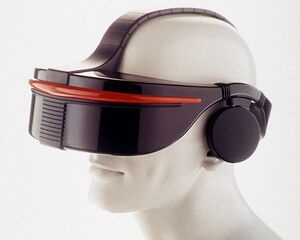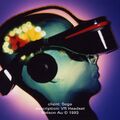Sega VR
From Sega Retro
Sega, flush with funds from the Sega Mega Drive, announced the Sega VR add-on in 1991. It was based on an IDEO virtual reality headset (HMD) with LCD screens in the visor and stereo headphones. Inertial sensors in the headset allowed the system to track and react to the movements of the user's head.
Because of development difficulties the Sega VR remained only a prototype, it was last seen at computer shows in 1993 and vanished from the release schedules in 1994. Four games were apparently developed for the system, each using 16 Mb cartridges that were to be bundled with the headset: Nuclear Rush, Iron Hammer, Matrix Runner and Outlaw Racer.
The company claimed the project was stopped because the VR was so real users would move while wearing the headset and injure themselves. The limited processing power of the system makes this claim unlikely, although there were reports of testers developing headaches and motion sickness. Mark Pesce, who worked on the Sega VR project, says the Stanford Research Institute warned Sega of the 'hazards of prolonged use [1].
Sega went on to other VR projects for use in arcades and a similar add-on was reported but never seen for the Sega Saturn. The project encouraged a brief flurry of other companies to offer VR products.
Sega VR in Popular Culture
Despite never receiving an official release, the Sega VR was featured in the Spike Lee movie "Clockers" (with a game called "Gangsta") and promotional material for the system had been created, leading to speculation that working units were produced before the system was discontinued. The Sega VR can be seen in this 1992 American commercial for Alpha-Bits cereal.
<mediaplayer title="Sega VR Alpha-Bits Commercial">File:SegaVR Alphabits commercial.flv</mediaplayer>

